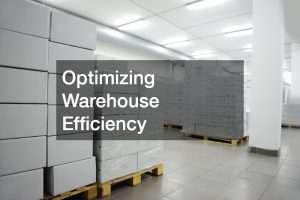Introduction
In today’s fast-paced economy, efficient operations and logistics cost reduction strategies have become more critical than ever. Rising fuel prices, increasing labor costs, and frequent supply chain disruptions put tremendous pressure on businesses to streamline their logistics processes. By adopting efficient logistics strategies, companies can significantly cut down on operational expenses, leading to increased profitability and competitiveness in the market.
The importance of logistics cost reduction cannot be overstressed, considering the financial and operational impacts businesses face due to inefficiencies in their supply chains. This need to refine logistics processes is not just about staying ahead of the competition but also about adapting to the evolving landscape of global trade and transportation. Embracing cost reduction strategies in logistics is crucial for maintaining a lean and agile operation capable of weathering economic fluctuations and market demands.
The following sections delve deep into practical strategies to enhance logistics efficiency, from conducting comprehensive audits to leveraging data analytics for continuous improvement. Each strategy not only aims to reduce costs but also to improve overall operational efficiency and customer satisfaction.
1. Conducting a Comprehensive Logistics Cost Audit
A thorough audit of your logistics processes is the first step towards identifying potential cost-saving opportunities. This involves analyzing every aspect of your logistics operations, including transportation, warehousing, and inventory management. By closely examining these areas, businesses can uncover inefficiencies such as unused storage space, redundant shipping routes, and excess inventory. An effective audit can lead to significant cost savings by addressing these inefficiencies head-on.
Auditing logistics processes not only helps in pinpointing areas that need improvement but also provides valuable insights for future strategic planning. Businesses that regularly conduct logistics audits can save an average of 10-15% on costs, highlighting the financial benefits of this essential practice. Utilizing digital tools like inventory management software can further streamline the auditing process, making it more efficient and accurate.
Conducting a logistics audit requires a systematic approach, including data collection, analysis, and implementation of corrective actions. It is essential to involve all stakeholders in the process to ensure a comprehensive evaluation. Businesses can use various performance metrics to assess the efficiency of their logistics operations and identify areas where costs can be reduced.
2. Optimizing Warehouse Efficiency

Warehouse efficiency is paramount for reducing logistics costs. Implementing lean warehousing techniques can significantly enhance operational efficiency by minimizing waste and maximizing resource utilization. Techniques such as optimizing storage layouts, implementing just-in-time inventory systems, and reducing unnecessary handling can lead to substantial cost savings.
Technology plays a crucial role in optimizing warehouse efficiency. Automated sorting systems and robotics can reduce human error and increase the speed of operations, leading to faster order fulfillment and lower labor costs. Investing in automation can be a game-changer, as seen in companies like Amazon, which has optimized its warehouse processes to save millions annually.
Effective warehouse management also involves regular performance evaluations and continuous improvement initiatives. Businesses should track key performance indicators (KPIs) such as order accuracy, fulfillment times, and labor efficiency to identify areas for improvement. By continuously refining warehouse processes, companies can achieve sustained cost reductions and operational efficiencies.
3. Route Optimization for Transportation Cost Savings
Transportation costs constitute a significant portion of logistics expenses. Using route optimization software can help minimize fuel consumption and reduce delivery times, leading to substantial cost savings. These tools leverage advanced algorithms and real-time data to determine the most efficient delivery routes, thus minimizing unnecessary mileage and fuel usage.
Optimized delivery routes can reduce fuel costs by up to 30%, making it a highly effective logistics cost reduction strategy. Companies like Uber and FedEx have successfully implemented AI-based route planning to streamline their transportation operations and achieve significant cost savings. By adopting similar technologies, businesses can enhance their logistics efficiency and reduce operational expenses.
In addition to route optimization, businesses should regularly review and adjust their transportation strategies to accommodate changes in demand, traffic patterns, and fuel prices. Collaborating with transportation providers and leveraging their expertise can also lead to more efficient and cost-effective logistics solutions. Continuous monitoring and adjustment of transportation strategies are essential for maximizing cost savings.
4. Partnering with Third-Party Logistics (3PL) Providers
Partnering with third-party logistics (3PL) providers can offer significant cost-saving opportunities for businesses. 3PL providers bring expertise, scalability, and advanced logistics capabilities that can help companies optimize their supply chains. By outsourcing logistics functions to 3PL providers, businesses can often achieve reduced freight costs and improved operational efficiencies.
The benefits of partnering with 3PL providers go beyond cost savings. 3PLs offer advantages such as consolidated shipping, better access to global markets, and advanced technology solutions. These providers can also help businesses navigate complex logistics challenges, from regulatory compliance to managing seasonal demand fluctuations.
Using 3PLs can lower total logistics costs by 12-15% annually, making it a compelling strategy for cost-conscious businesses. By leveraging the expertise and resources of 3PL providers, companies can focus on their core competencies while leaving logistics management to specialists. This partnership can lead to more efficient supply chains, reduced costs, and enhanced customer satisfaction.
5. Implementing Sustainable Practices to Cut Costs

Incorporating sustainable practices into logistics operations can lead to significant cost savings in the long run. Businesses can switch to eco-friendly packaging, reduce energy use in warehousing, and opt for fuel-efficient vehicles to minimize their environmental impact and operating costs. These sustainability efforts not only contribute to cost reductions but also enhance the company’s reputation as a responsible and eco-conscious entity.
Sustainable logistics practices such as energy-efficient lighting, solar power installations, and waste reduction initiatives can lead to lower operating costs. Companies that invest in sustainability often find that the initial expenses are outweighed by long-term savings. For instance, energy-efficient lighting in warehouses can lead to substantial reductions in electricity bills over time.
Sustainable logistics practices can lower long-term costs by up to 20%, making them an attractive option for businesses looking to reduce their expenses. By prioritizing sustainability, companies can achieve a dual benefit of cost savings and enhanced corporate social responsibility. This approach aligns with the growing consumer demand for environmentally friendly products and practices.
6. Reducing Inventory Carrying Costs
Reducing inventory carrying costs is a critical aspect of logistics cost reduction strategies. Implementing just-in-time (JIT) inventory management can help businesses minimize excess inventory, reducing storage and depreciation costs. Accurate demand forecasting and inventory planning are essential for maintaining optimal stock levels and avoiding overstocking or stockouts.
Investing in forecasting software and predictive analytics can enhance the accuracy of inventory management. These tools use historical data and market trends to predict future demand, enabling businesses to adjust their inventory levels accordingly. By optimizing inventory management, companies can significantly reduce carrying costs and improve cash flow.
For example, Toyota’s Just-in-Time model has saved millions in inventory costs by ensuring that materials and products are received only as they are needed in the production process. This approach reduces the need for large storage facilities and lowers the risk of inventory obsolescence. Businesses can adopt similar JIT strategies to achieve substantial cost savings in their logistics operations.
7. Negotiating Better Contracts with Suppliers
Regularly reevaluating and negotiating contracts with suppliers is essential for achieving better terms and reduced logistics costs. Businesses can leverage their purchasing power by negotiating bulk ordering discounts, long-term contracts, and strategic partnerships. These tactics can lead to improved shipping and warehousing rates, ultimately lowering logistics expenses.
Negotiating better contracts requires a thorough understanding of the supply market and the ability to identify areas where cost savings can be achieved. Companies should engage in open and transparent discussions with suppliers to explore mutually beneficial arrangements. These negotiations can result in significant savings, especially for large-scale operations with high purchasing volumes.
Walmart’s supplier negotiations are a prime example of how effective contract management can lead to reduced logistics costs. By building strong relationships with suppliers and negotiating favorable terms, Walmart has been able to optimize its supply chain and achieve substantial cost savings. Other businesses can emulate this approach to enhance their logistics efficiency and reduce expenses.
8. Enhancing Customer Satisfaction through Better Logistics
Improving logistics processes can have a direct impact on customer satisfaction. Faster delivery times, accurate order fulfillment, and reliable shipping services are crucial for meeting customer expectations. By optimizing logistics operations, businesses can enhance customer satisfaction, leading to increased loyalty and repeat business.
Customer loyalty is closely tied to the efficiency of logistics operations. Customers are more likely to return to businesses that consistently deliver products on time and in good condition. Reducing shipping errors and improving delivery accuracy can significantly enhance the overall customer experience.
Enhancing customer retention strategies through personalized marketing can further align logistics with customer expectations. By customizing logistics services to meet individual customer needs, businesses can build stronger relationships and foster loyalty. Efficient logistics operations play a vital role in ensuring customer satisfaction and driving long-term business success.
9. Leveraging Data Analytics for Continuous Improvement
Data analytics is a powerful tool for continuous improvement in logistics operations. By tracking key performance indicators (KPIs) such as order accuracy, delivery times, and cost per mile, businesses can gain valuable insights into their logistics processes. Analyzing this data helps identify areas for improvement and implement targeted strategies for cost reduction.
Data-driven decisions are essential for optimizing logistics operations and addressing potential challenges proactively. Predictive analytics can forecast future logistics trends and help businesses plan accordingly. This approach enables companies to stay ahead of market changes and optimize their supply chains for maximum efficiency.
Companies using data analytics can reduce logistics costs by 15-20%, making it a critical component of cost reduction strategies. By continuously monitoring and analyzing logistics data, businesses can identify inefficiencies, implement corrective actions, and achieve sustained cost savings. This approach fosters a culture of continuous improvement and operational excellence.
10. Training and Employee Engagement for Logistics Efficiency
Investing in regular employee training is essential for enhancing operational efficiency in logistics management. Well-trained employees are more capable of identifying and implementing cost-saving opportunities within the logistics process. Training programs should focus on best practices, safety protocols, and the effective use of technology and equipment.
Employee engagement is another crucial factor in achieving logistics efficiency. Creating incentive programs can motivate employees to suggest and implement cost-saving initiatives. Recognizing and rewarding employees for their contributions to cost-reduction efforts can lead to a more proactive and committed workforce.
A case study on UPS highlights the importance of training and employee engagement in logistics efficiency. UPS trained its drivers to cut fuel costs and optimize delivery routes, resulting in significant savings. By investing in training and fostering a culture of continuous improvement, businesses can achieve substantial cost reductions and enhance overall logistics performance.
Conclusion
Logistics cost reduction strategies are essential for improving operational efficiency and reducing overall expenses. Businesses can identify and address inefficiencies in their logistics processes by conducting comprehensive audits, optimizing warehouse efficiency, and leveraging data analytics. Implementing sustainable practices, partnering with 3PL providers, and negotiating better contracts with suppliers are additional strategies that can lead to significant cost savings.
Enhancing customer satisfaction through better logistics and investing in employee training and engagement further contributes to cost-reduction efforts. Businesses that adopt these strategies can achieve a leaner and more agile operation, capable of adapting to market changes and maintaining a competitive edge. The importance of logistics cost reduction in today’s economy cannot be overstressed, as it directly impacts profitability and long-term business success.
Encouraged by these insights, homeowners and small businesses should start auditing their logistics processes and implementing the strategies discussed in this article. By taking proactive steps towards logistics cost reduction, they can achieve greater efficiency, lower expenses, and improved customer satisfaction.
“`